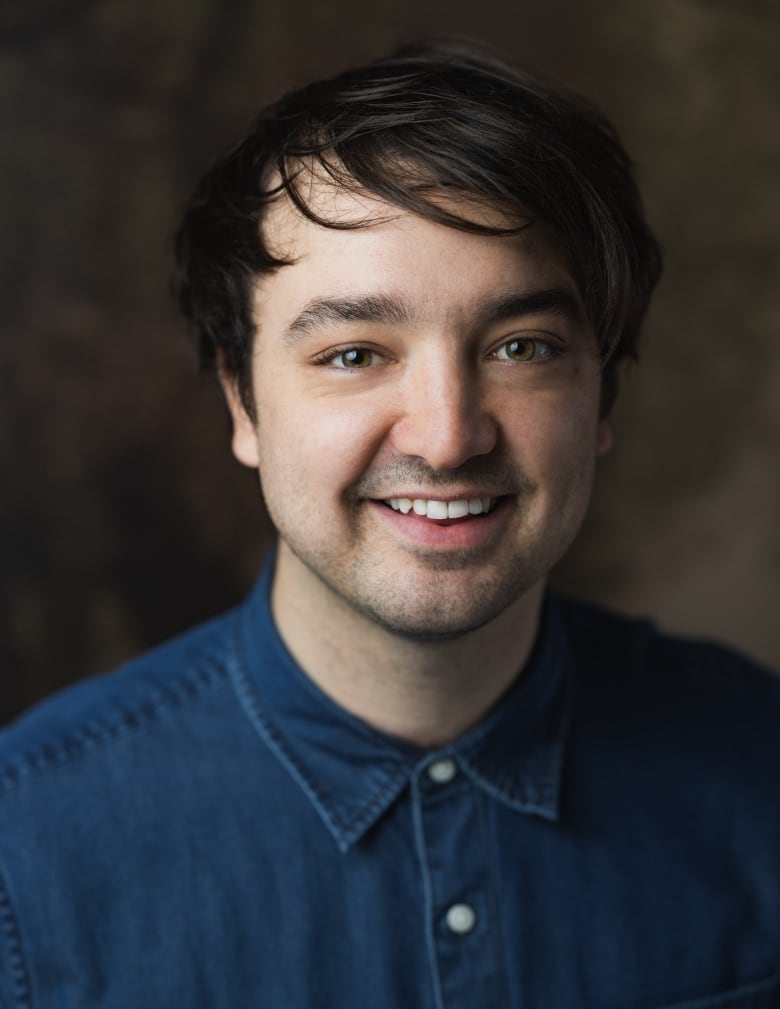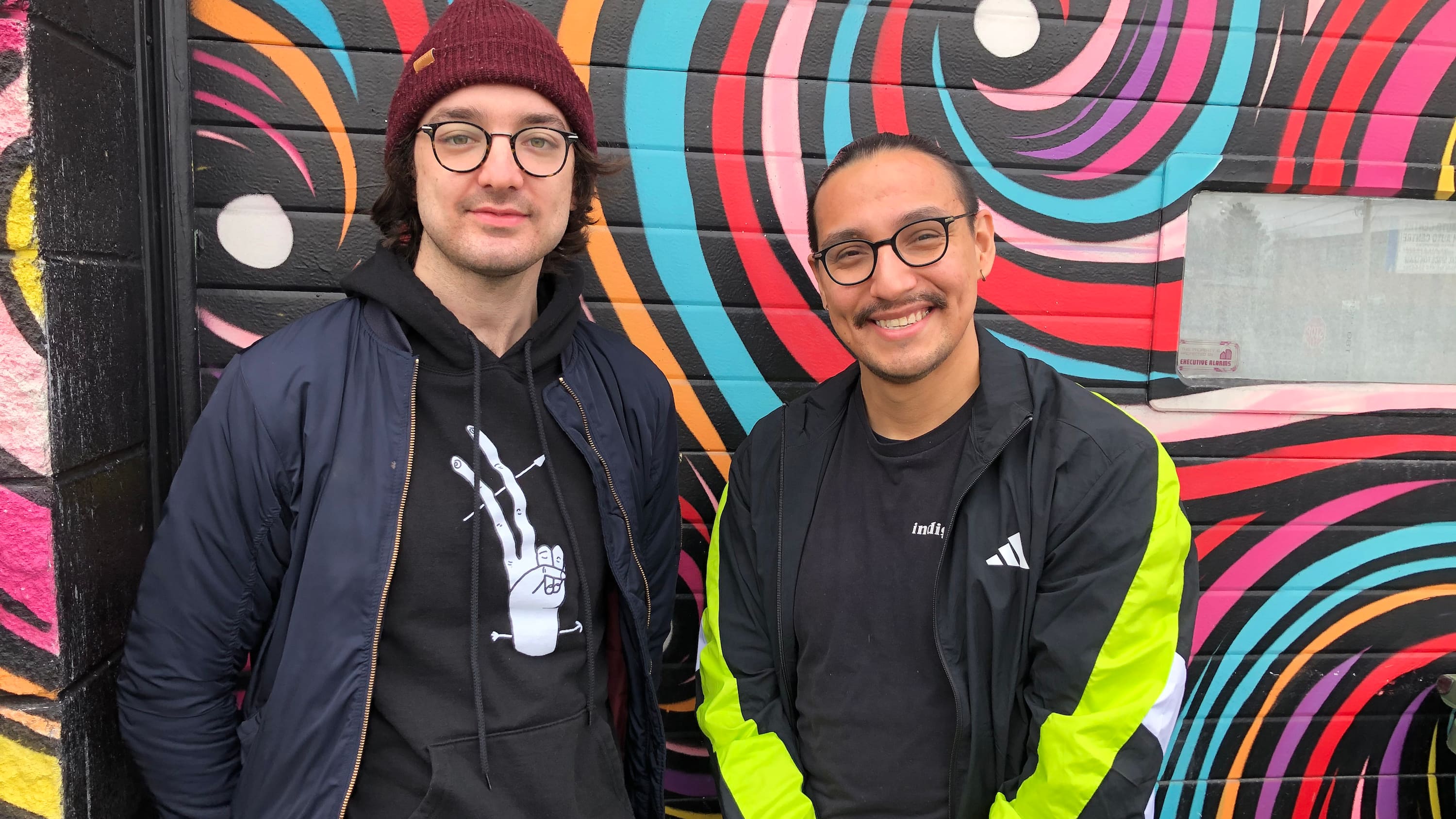Unreserved51:00Using music to tell Indigenous stories
It’s a short trip to the office for Justin Delorme, whose home studio begins where his living space ends. The room is filled with recognizable instruments — a drum kit, cello and guitar among them. But the tools of a composer differ from those in a typical music studio, and so there are also instruments such as the pedal steel guitar, which Delorme says is a bit of an oddball in the guitar world.
“It’s like a slab of wood with, in this case, 10 strings. And you play it like a guitar but it uses a bar instead of your fingers and you operate it with your feet and your knees,” said Delorme, who is Red River Métis with Métis and settler ancestry.
The uniqueness of an instrument like the pedal steel guitar adds to the immense catalogue of sound Delorme uses for his compositions for film, TV, podcasts and video games. With a double monitor setup for his computer, he watches a silent film or television episode on one side while controlling all of his recording tracks and virtual instruments on the other.
It’s how he produced scores for the hundreds of films and television episodes already under his belt, which include scores in APTN’s Taken and the documentary Buffy Sainte-Marie: Carry It On.
While technology is making composing more accessible to more artists, Delorme says there’s another important shift going on: scoring Indigenous stories with Indigenous music — rather than a cliché of rattles and drums.
‘Golden age of technology’
It’s not what Delorme imagined the work of a composer to be.
“When I was growing up, I would imagine Beethoven or someone with a wig and they would be fiercely writing notation on paper. But for me it’s, you know, kind of sitting at the computer a lot of the time and messing around with sounds and recording them as I go and just piecing together a puzzle of different sounds to match what I’m seeing on the screen.”

The technology available to musicians and composers like Delorme is much more advanced than the studios of just a few decades ago, and more affordable too. Delorme says it makes the world of composition far more accessible to Indigenous musicians like himself who have more studio options — in some cases situated in their own homes.
The cost of creating a score is also reduced by the applications of those studios: for example, a computer program can simulate the sound of multiple instruments, often eliminating the need to hire multiple musicians for a recording.
“It’s a golden age of technology right now for musicians in particular … we’re able to make music faster and better than ever before with just a better sound and, you know, you can get to the heart of what you actually want to be doing, which is making the best music you can do.”
Delorme says the other shift in the industry that is bringing more Indigenous composers on the scene is the increased opportunity for Indigenous writers to tell their stories in their own ways. Delorme cites filmmakers like Madison Thomas and Mary Galloway among the young filmmakers leading the way.
A catalogue of Indigenous music
Delorme’s work is also part of a music library called Bedtracks used by producers and broadcasters, including CBC. In 2018, responding to demand for more Indigenous content, Bedtracks launched a small catalogue in partnership with the ImagineNATIVE Film and Media Arts Festival.
Bedtracks’ first Indigenous catalogue was so popular that it quickly grew from a few hundred to a few thousand tracks. Now under the name Nagamo Publishing, the library is a centralized place to find Indigenous music for media productions.
“[The catalogue] came specifically out of this need for an access point for music that was Indigenous, felt Indigenous, was able to help tell these stories, but was in fact made by indigenous people,” said Nigel Irwin, co-creative director of Nagamo Publishing.
“For the longest time that wasn’t the case. Essentially, people were just putting shakers and drums on things and calling it a sound,” he said.
WATCH | Why Nagamo saw the need for an Indigenous music library:
Creators have launched what they say is the world’s first Indigenous-created music production library. Nagamo Publishing features nearly 1,600 tracks created by Indigenous artists that can be licensed for use as soundtracks in film, TV and other media. Our Toronto host Marivel Taruc spoke with the platform’s creators.
Irwin says the demand is growing, worldwide.
“The definition of Indigenous music is so excitingly broad. I would say there’s a through-line between international communities that you can find a common experience,” he said.

For Irwin, this network of Indigenous musicians and composers will shape the next evolution of music scores.
“Where it gets really exciting is when remix comes into play, where you’ve got people from different communities and cultures — it’s kind of like remixing each other’s sounds in a way that’s respectful and, you know, consensual,” said Irwin.
Beyond flutes and rattles
In achieving that perfect score, Delorme says his production notes often sound different when he works on Indigenous-led projects. For example, he says Indigenous producers never ask him to make “Indigenous sounding” music.
“Sometimes a lot of the notes from non-Indigenous folks is: ‘Can you make it more Indigenous?’ which is a really hard thing to respond to.”
Delorme says that while he understands why some production teams might include traditional instruments like flutes or rattles in scores that support Indigenous story, he likes to incorporate a bigger body of sound. And while he often gravitates to acoustic instruments for these scores, he says there’s no limits to what Indigenous music can be.
“I just worked on an Indigenous feature film that had a ton of synthesizers on it. Synthesizers can be Indigenous.”
The evolution of what it means to make Indigenous music requires an openness from mainstream media. It also requires the creation of safe spaces where Indigenous talent is valued. Irwin says this comes with fair pay but also making space for more Indigenous people on production teams.
“Personally, I’ve noticed that with projects that have a core Indigenous team, there’s a level of trust there that I don’t think you can get from outside perspectives. It’s a really valued thing within the creative team, ” said Irwin.
For Delorme, he says he’s still on a journey to better understand what makes him different from other composers. And while he continues his work with media productions, there are other spaces to develop talent and a sense of identity as well.
“I’m trying to get into more projects that challenge me, that get me out of any comfort zones … basically make the best music I can and try to tell the best stories I can along with all my close collaborators and friends that are making films and television.”
Source link
#Demand #Indigenous #composers #growing #worldwide #industry #insiders #CBC #Radio

